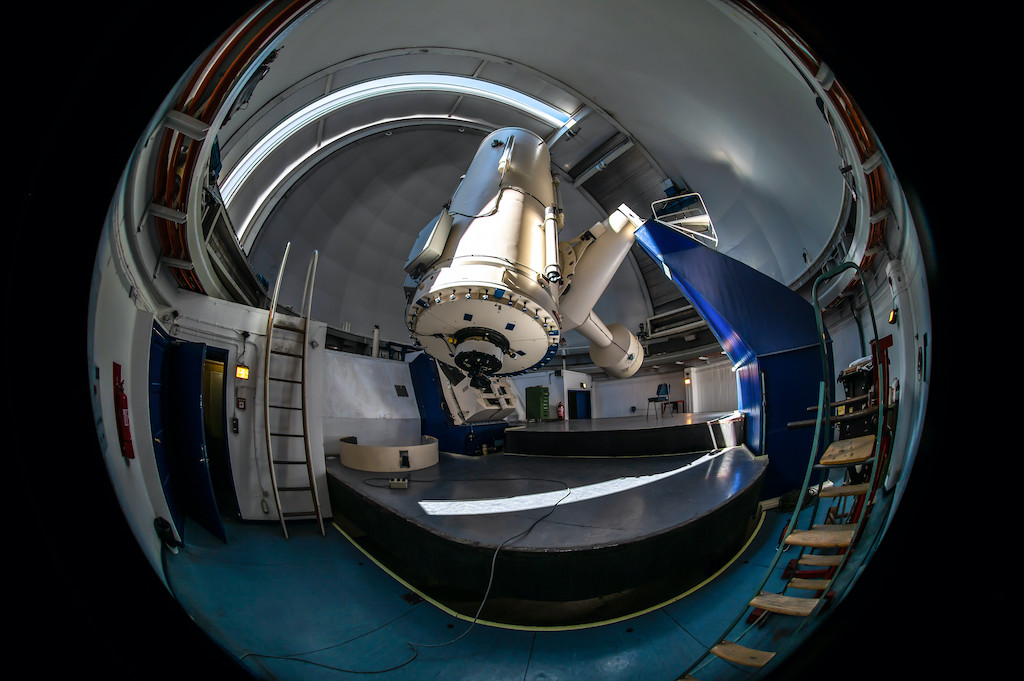As part of an international consortium, the Thuringian State Observatory has put a new spectrograph into operation. This optical instrument is used to study the activity of stars and discover possible companions. The spectrograph was installed on the modernized 1.52-metre telescope of the European Southern Observatory in La Silla, Chile, in November 2024 and is ready for operation. This means that the Thuringian State Observatory now also has an observation instrument for the night sky of the southern hemisphere.
With the new “PLATOSpec” spectrograph on the 1.52-metre telescope of the European Southern Observatory (ESO) in La Silla, Chile, researchers at the Thuringian State Observatory can observe stars in the southern night sky. The telescope was built in the 1960s and has been given new life.
 The modernized 1,52-Metre-Telescope at the ESO La Silla Observatory in Chile. Credit: Zdeněk Bardon/ESOThe Thuringian State Observatory is part of a consortium that had the idea of modernizing the telescope and equipping it with a new spectrograph. After just under two years of construction, the spectrograph was connected to the modernized telescope and tested in November 2024. It is now ready for scientific research.
The modernized 1,52-Metre-Telescope at the ESO La Silla Observatory in Chile. Credit: Zdeněk Bardon/ESOThe Thuringian State Observatory is part of a consortium that had the idea of modernizing the telescope and equipping it with a new spectrograph. After just under two years of construction, the spectrograph was connected to the modernized telescope and tested in November 2024. It is now ready for scientific research.
As part of the modernization the telescope and the spectrograph can be operated remotely. An observation room was set up at the Thuringian State Observatory specifically for this purpose. Markus Roth, Director of the Thuringian State Observatory, explains why this instrumentation project is important for research in Thuringia: “PLATOSpec enables us to observe stars in the southern night sky from Tautenburg and to participate in major international research projects.”
The tasks of the new spectrograph
The new high-resolution spectrograph “PLATOSpec” is a versatile research instrument. It was specially developed to better investigate the magnetic activity of stars. Its main task is to support the European Space Agency's PLATO satellite telescope with observations from Earth. PLATOSpec will characterize stars with planets and search for other planets. The PLATO satellite telescope is due to be launched in 2026 and will initially observe millions of stars in the southern night sky.
These stars will be further examined with telescopes on Earth: How strong is their magnetic activity? Do they possibly have a companion, for example one or more planets orbiting around them? How big is the mass of these planets? PLATOSpec's task is to vet stars: stars that potentially could have Earth-like planets are identified so that they can then be further observed with a large telescope such as ESO's Very Large Telescope (VLT).
An international project
 The various components of the PLATO Spec instrument on the ESO 1.52-m telescope. Credit: Leonardo VanziThe consortium partners who modernized the 1,52-metre-telescope, financed and built the spectrograph PLATOSpec are the Astronomical Institute of the Czech Academy of Sciences (responsible for the telescope modernisation and front end), the German Thuringian State Observatory Tautenburg (calibration unit), the Pontificia Universidad Católica de Chile (spectrograph). The research funding of the Free State of Thuriniga financed the share of the Thuringian State Observatory in the PLATOSpec project.
The various components of the PLATO Spec instrument on the ESO 1.52-m telescope. Credit: Leonardo VanziThe consortium partners who modernized the 1,52-metre-telescope, financed and built the spectrograph PLATOSpec are the Astronomical Institute of the Czech Academy of Sciences (responsible for the telescope modernisation and front end), the German Thuringian State Observatory Tautenburg (calibration unit), the Pontificia Universidad Católica de Chile (spectrograph). The research funding of the Free State of Thuriniga financed the share of the Thuringian State Observatory in the PLATOSpec project.
The workshops of the Thuringian State Observatory have developed, built and tested the calibration unit for the PLATOSpec spectrograph. The calibration unit serves as a reference point for the spectra recorded with the telescope. It was installed on the telescope at the end of March 2024 together with a new front end. The front end connects the spectrograph to the telescope. It was also commissioned by the Thuringian State Observatory and financed by the Free State of Thuringia.
Eike Guenther, astronomer at the Thuringian State Observatory, helped plan the project and accompanied the commissioning of PLATOSpec at ESO's La Silla Observatory in Chile: “With PLATOSpec and the modernized telescope, the Thuringian State Observatory now has the opportunity to observe stars at one of the best astronomical locations in the world. I am delighted that we can make an important contribution to the PLATO satellite telescope with this instrument.”
Links

